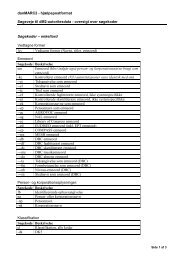RFID Data Model for Libraries - biblstandard
RFID Data Model for Libraries - biblstandard
RFID Data Model for Libraries - biblstandard
You also want an ePaper? Increase the reach of your titles
YUMPU automatically turns print PDFs into web optimized ePapers that Google loves.
<strong>RFID</strong> <strong>Data</strong> model <strong>for</strong> libraries Doc 067<br />
Summary<br />
This report is the result of the work of the <strong>RFID</strong> <strong>Data</strong> model <strong>for</strong> libraries working group. The<br />
working group was established in November 2004 and affiliated to Danish Standard S24/u4 in<br />
cooperation with the <strong>RFID</strong> vendors on the Danish library scene. The purpose was to establish<br />
an <strong>RFID</strong> <strong>Data</strong> <strong>Model</strong> <strong>for</strong> the Danish market with a view to providing the background <strong>for</strong><br />
international initiatives in standardisation <strong>for</strong> libraries.<br />
The organisations behind the working group are:<br />
3M Germany.<br />
Axiell Bibliotek AB.<br />
Bibliotheca <strong>RFID</strong> Library Systems AG.<br />
Dantek A/S.<br />
DBC medier.<br />
Draupnir.<br />
Codeco.<br />
FKI Logistex A/S.<br />
P.V. Supa Oy Ltd.<br />
Tagsys.<br />
TagVision.<br />
Tårnby Kommunebiblioteker.<br />
Hein In<strong>for</strong>mation Tools<br />
The data model proposal report consists of three parts plus annexes:<br />
Part 1 contains background in<strong>for</strong>mation, <strong>for</strong>malities and progress of the work.<br />
Part 2 outlines the principal demands <strong>for</strong> a data model and presents the discussion on choices<br />
and options to consider and the conclusions. There is the selection of data elements to be<br />
included and the construction of mandatory and optional elements. Important conclusions are<br />
the standards background in the ISO/IEC 18000 family with the choice of the 13.56 MHz<br />
frequency. The rest of the work is based on the ISO/IEC 15961-63 standards. For encoding<br />
UTF-8 is specified. The data model does not cover security issues. There is a discussion on<br />
usage of AFI. However, this issue is still open.<br />
Part 3 is the detailed data model defining data elements, the structure of data elements,<br />
encoding and value range. The complete structure <strong>for</strong> <strong>RFID</strong> tags <strong>for</strong> library usage including<br />
encoding and check facilities.<br />
5




